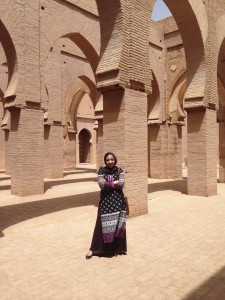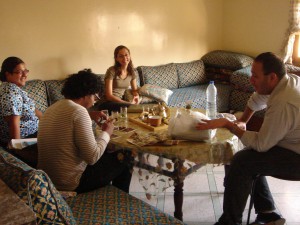
Armaan Siddiqi, 2011-2012, Morocco, stands in the historic Tin Mal mosque in the High Atlas Mountains. The mosque, an architectural feat and current UNESCO world heritage site, was constructed in the twelfth century during the Almohad Dynasty to commemorate its famous ruler, Mohamad Ibn Tumart.
After navigating a series of sinuous allies in the sprawling labyrinth that is the old city of Fez, I finally arrive at my destination: the ornate shrine and mosque of Moulay Idriss II—the patron saint of Fez and son of the first ruler of Morocco. I breathe a deep sigh of relief: finally, I’ve found it! I tiptoe in, allowing the sights and sounds of the shrine to wash over me. I find a quiet corner and begin journal entry #1: “This is but the first of many sacred sites I aspire to visit while researching Islam in Morocco this year…”
Rereading the above excerpt, written four years ago as a wide-eyed Fulbright U.S. Student researcher in Morocco, fills me with immense nostalgia and gratitude; my Fulbright experience was, without any exaggeration, one of the most formative experiences of my life, personally and professionally. In delving deep into Islamic history and theology for my research, I not only deepened an understanding of my project (which examined the relationship between Muslim piety and Moroccan politics) but I also realized the tremendous diversity of Islam, and my fellow Muslims.
Living in Morocco as an American Muslim of Pakistani origin made for particularly interesting encounters. Casual conversations with Moroccans, other students and travelers from around the world routinely transformed into profound and passionate discussions on race, faith and politics in the U.S. and Middle East. Little did I realize then that these impromptu conversations would also contribute greatly to my research. Indeed, some of the greatest lessons during one’s Fulbright year arise from the most coincidental circumstances: a chance encounter with a Moroccan-American expatriate at an ATM machine in Fez, for example, led to an afternoon of hearing spooky djinn stories from his childhood with another Fulbright friend researching Moroccan folklore. Through my host institution—the Sidi Mohamad ben Abdallah University of Fez, I was connected with very helpful faculty and students who further enriched my research and invited me to collaborate with their exciting projects.

Mohamad, our Moroccan-American friend mentioned above (right), served traditional Moroccan mint tea to fellow Fulbrighters and I at his family’s home in Fez. We met by chance at an ATM machine! Mohamad recounts djinn stories and other childhood memories while sharing family photos with us. Samuel Gordon (second from right), fellow Fulbright Alumni Ambassador, takes notes for his Fulbright project documenting Moroccan folklore and mysticism.
By the end of my nine months—which felt like a whirlwind—I truly felt “at home” in Morocco. Even though I was constantly on the move visiting sacred sites throughout the country, I found a deep sense of comfort and confidence in traveling and communicating effectively, thanks to numerous lessons in Arabic and cultural etiquette from Moroccan teachers, friends, fellow Fulbrighters and even strangers.
My advice for future applicants is: it doesn’t hurt to apply! It is easy to get caught up in letters and numbers (grades, GPAs, etc.) thus loosing sight of subtler, yet highly competitive, qualifications: an open-minded personality, a culturally sensitive outlook, etc. Be sure to showcase those aspects, too.
And if you are particularly interested in the MENA region, don’t let your lack of near-fluency in Arabic (or other local languages) deter you! It is expected that you’ll spend a considerable amount of your time in country studying new languages. After all, some of the most profound cross-cultural exchanges happen in the context of learning how to communicate! Let your passion and sensitivity guide you in crafting a project that reflects not only your academic credentials, but also your potential to be a keen and compassionate cultural ambassador. Good luck!

No Comments